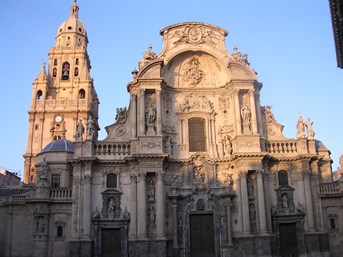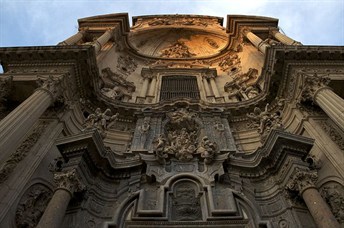The cathedral of Murcia
 Like many other Spanish cathedrals, the Cathedral of Santa María (Saint Mary) of Murcia is the result of the stratification, which took place over several centuries, of different styles and tastes. Nevertheless, it may be included among the monuments of Baroque art in Spain. Moreover, the entire city of Murcia is one of the urban centres which is most heavily characterized by the culture and style of the Baroque.
Like many other Spanish cathedrals, the Cathedral of Santa María (Saint Mary) of Murcia is the result of the stratification, which took place over several centuries, of different styles and tastes. Nevertheless, it may be included among the monuments of Baroque art in Spain. Moreover, the entire city of Murcia is one of the urban centres which is most heavily characterized by the culture and style of the Baroque.
Though the Christian Reconquista of Murcia had been completed as early as the thirteenth century, the construction of the cathedral only began a century later. At first, as happened in many other cities taken from Arab rule, the mosque was simply adapted to Christian worship. The work of building the new Church began in 1394, under Bishop Fernando de Pedrosa. Consecrated in 1465 but actually completed in 1467, the church underwent a number of changes and additions in later centuries, sometimes as a result of fortuitous events such as the great fire in 1854 that destroyed the altar and the choir.
The medieval origins of the building are clearly visible in the interior, a perfect example of Gothic style. The three naves, each of different height and with a final apse, hold the remains of many illustrious Murcians of the past, such as those of the seventeenth century writer, Diego de Saavedra FajardoDiego de Saavedra Fajardo (1584-1648) was a Spanish writer and diplomat. His most famous work is the treatise Empresas Políticas o Idea de un príncipe cristiano representada en cien empresas, (Political Exploits or the Ideal of a Christian Prince represented in one hundred exploits), published in 1640. He was secretary to Cardinal Gaspar Borgia and held important diplomatic missions. He was one of the representatives of Spain in the peace congress of Münster (1648)., and the remains of the so-called Cuatro Santos de Cartagena, the patrons of the diocese of which Murcia is the head: Fulgentius, Isidore, Leander and Florentina. The urn containing the heart and bowels of King Alfonso X the Wise is also kept in the main chapel.
Twenty-three chapels stand out within the interior of the cathedral which were built at various times in honour of the patron saints or bishops and nobles who helped finance the construction of the church. The most famous is the Capilla de los Vélez, whose construction began in 1490 under Bishop Rodrigo de Borja, the future Pope Alexander VIRoderic Llançol de Borja (1431-1503) was elected pope in 1492 with the name of Alexander VI. A nephew of Pope Callistus III, he had several children and several lovers, the most famous of which was Giulia Farnese.. Its name is derived from the Marquises de los Vélez, who financed its construction and used it for centuries as a private chapel. The style is flamboyant gothic, with a polygonal plan. Also famous is the Capilla de Junterón, a great work of Spanish Renaissance architecture built on the project of the Italian Jacopo Fiorentino and above an earlier Gothic chapel. The prothonotary apostolic Gil Rodríguez de Junterón financed the construction work, giving his name to the chapel, and is still buried there.
 Baroque art is thus absent in the interior of the church, with the exception of the Capilla de la Inmaculada, erected in the first half of the seventeenth century and the first in the world to be consecrated according to the dogma of the Immaculate Conception. However, what makes the cathedral of Murcia one of the most impressive examples of Baroque architecture is the outside, and especially the monumental stone façade. The previous façade, dating from the sixteenth century, was demolished following the damage caused by earthquakes and floods. The architect Jaime BortJaime Bort y Meliá (?-1754) was a Baroque sculptor and architect. His most famous work is undoubtedly the façade of the Cathedral of Murcia, rebuilt in 1737 due to repeated damage from weather and natural and extraordinary events. He died in 1754. designed a new façade resembling a large altarpiece facing the square. The work, which lasted from 1737 to 1754, gave birth to a perfect example of Baroque aesthetics. The façade is divided into three vertical sections by large columns, while large spirals join the sides to the centre section. At the base, three doors open, corresponding to the three naves: the door of San José (Saint Joseph) or the Cabildo (Chapter house), the door of San Juan (Saint John) or the Consejo (Counsel) and the central door, called del Perdon (of Forgiveness), open only on the occasion of great solemnities. A series of Corinthian columns and sculptures, such as that of the Virgin with angels, together with the central window in the wall of the second floor, enrich the spectacular front concave. The large statue of the apostle Santiago (Saint James), who according to tradition entered the Iberian Peninsula through the port of Cartagena, was removed from the top of the façade at the beginning of the nineteenth century. This statue was, however, only one of the many sculptures used to decorate and enrich the complex.
Baroque art is thus absent in the interior of the church, with the exception of the Capilla de la Inmaculada, erected in the first half of the seventeenth century and the first in the world to be consecrated according to the dogma of the Immaculate Conception. However, what makes the cathedral of Murcia one of the most impressive examples of Baroque architecture is the outside, and especially the monumental stone façade. The previous façade, dating from the sixteenth century, was demolished following the damage caused by earthquakes and floods. The architect Jaime BortJaime Bort y Meliá (?-1754) was a Baroque sculptor and architect. His most famous work is undoubtedly the façade of the Cathedral of Murcia, rebuilt in 1737 due to repeated damage from weather and natural and extraordinary events. He died in 1754. designed a new façade resembling a large altarpiece facing the square. The work, which lasted from 1737 to 1754, gave birth to a perfect example of Baroque aesthetics. The façade is divided into three vertical sections by large columns, while large spirals join the sides to the centre section. At the base, three doors open, corresponding to the three naves: the door of San José (Saint Joseph) or the Cabildo (Chapter house), the door of San Juan (Saint John) or the Consejo (Counsel) and the central door, called del Perdon (of Forgiveness), open only on the occasion of great solemnities. A series of Corinthian columns and sculptures, such as that of the Virgin with angels, together with the central window in the wall of the second floor, enrich the spectacular front concave. The large statue of the apostle Santiago (Saint James), who according to tradition entered the Iberian Peninsula through the port of Cartagena, was removed from the top of the façade at the beginning of the nineteenth century. This statue was, however, only one of the many sculptures used to decorate and enrich the complex.
 The big belltower is the true symbol, not only of the cathedral, but of the entire city of Murcia. At 98 metres high, its construction lasted almost three centuries. The first floor was built in 1521 in Renaissance style under the direction of Francesco and Jacopo Fiorentino. The second floor was completed in 1555, under the guidance of Jerónimo Quijano. The construction works were stopped at this level for more than two centuries, due to the alarming inclination of the tower, until the architect José López was able to overcome the problem by raising the third floor starting from 1765, in the Baroque style. In later years the fourth floor was raised, characterized by the four small temples dedicated to the Saints Fulgentius, Isidore, Leander and Florentina and the fifth floor, in Rococo style, where the 25 bells of the cathedral are found. The Neoclassical dome, designed by Ventura RodríguezTizón Buenaventura Rodríguez, better known as Ventura Rodríguez (1717-1785) is regarded as the last Spanish Baroque architect, although his production already had elements typical of Neoclassicism. Among his works are the inside of the Monastery of the Encarnación (Incarnation), the exterior of the Palace of Liria and the design of the fountain of Cibeles in Madrid, the façade of the convent of the Agustinos Filipinos in Valladolid and the Santa Capilla of the Basilica of Nuestra Señora del Pilar (Our Lady of Pilar) in Zaragoza., and the lantern on top of the tower marked the end of construction in 1793.
The big belltower is the true symbol, not only of the cathedral, but of the entire city of Murcia. At 98 metres high, its construction lasted almost three centuries. The first floor was built in 1521 in Renaissance style under the direction of Francesco and Jacopo Fiorentino. The second floor was completed in 1555, under the guidance of Jerónimo Quijano. The construction works were stopped at this level for more than two centuries, due to the alarming inclination of the tower, until the architect José López was able to overcome the problem by raising the third floor starting from 1765, in the Baroque style. In later years the fourth floor was raised, characterized by the four small temples dedicated to the Saints Fulgentius, Isidore, Leander and Florentina and the fifth floor, in Rococo style, where the 25 bells of the cathedral are found. The Neoclassical dome, designed by Ventura RodríguezTizón Buenaventura Rodríguez, better known as Ventura Rodríguez (1717-1785) is regarded as the last Spanish Baroque architect, although his production already had elements typical of Neoclassicism. Among his works are the inside of the Monastery of the Encarnación (Incarnation), the exterior of the Palace of Liria and the design of the fountain of Cibeles in Madrid, the façade of the convent of the Agustinos Filipinos in Valladolid and the Santa Capilla of the Basilica of Nuestra Señora del Pilar (Our Lady of Pilar) in Zaragoza., and the lantern on top of the tower marked the end of construction in 1793.
Finally, the Cathedral Museum, which houses many works of art of a religious character dating from Roman times to the contemporary age, must be mentioned. In the same area of the building there are the characteristic soportales, arcades in Baroque style that originally were integrated into the cloister of the cathedral.
